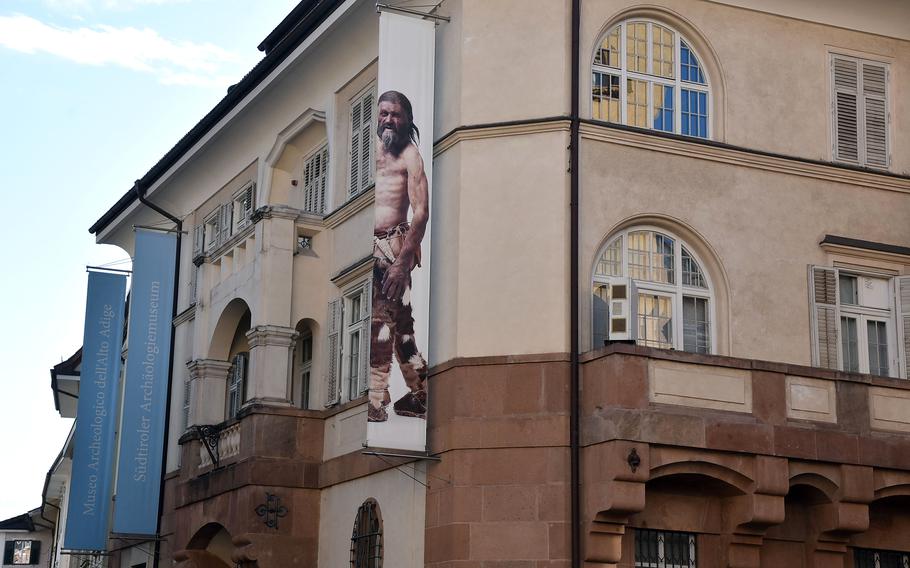
The South Tyrol Museum of Archaeology houses Ötzi, a Bronze Age man discovered frozen in the Alps in 1991. His mummified remains, which predate the Roman Empire by thousands of years, can be viewed through a small window on the first floor. Clothing and gear he was found with are also on display along with other exhibits on the Bronze Age. (Kent Harris/Stars and Stripes)
One of history’s greatest whodunits centers on a man killed in the Alps about 5,300 years ago and whose well-preserved body was discovered encased in ice in 1991.
Since then, the millennia-old cold case of Ötzi the Iceman has captivated professionals and the public alike, giving a museum in Bolzano, Italy, quite the showpiece with which to draw visitors.
A city of about 100,000 people roughly 50 miles south of the Austrian border, Bolzano is approximately two hours and 15 minutes from Vicenza by car.
The South Tyrol Museum of Archaeology houses Ötzi along with the clothing he was wearing and equipment he was using at the time of his death.
Today, the Iceman can be viewed through a small window on the museum’s first floor. Bits of clothing and other personal items, such as his ax, are displayed elsewhere on the same floor. Information is provided in Italian, German and English.
No photographs are allowed on the first floor, though visitors are allowed to use their cameras on the other two floors featuring exhibits.
One focuses on life in the Bronze Age in the area and some scientific guesses on Ötzi’s life and demise. The top floor currently features an exhibition title “Past Food: 15,000 Years of Nutrition.”
Ötzi’s story is largely known around Europe and has been told numerous times in American media outlets as well. The museum is well worth a visit for those interested in history.
But there’s more to Bolzano than the Iceman, although the drive between Austria and Verona along the A22 autostrada doesn’t reveal that.
Nothing of the old town is easily visible from the highway, where the view is mostly of factories or large and uninteresting structures..
The city’s heart, especially in winter, is Walterplatz, a square named after a famous German minstrel, Walter von der Vogelweide. Bolzano is known as Bozen to German speakers, and there are quite a lot of them.
The Tyrol region has been a part of modern Italy only since the end of World War I. So don’t be surprised if the place feels — and sounds — a bit more like Austria or Germany.
Restaurants serving dishes such as schnitzel are as common as pizzerias along the pedestrian streets that branch out from the square toward the museum. The Adige River and a tributary are a few more blocks away to the south and west.
Bolzano boasts a few churches, including the cathedral next to the main square, and a few small castles as well.
A cable car up takes people up into the Alps, providing an excellent option for hikers or those who just want to get above it all for a while and take in the views.
Bolzano also has consistently ranked near the top of annual surveys of most livable cities in Italy. So maybe you’ll want to stay longer — though not likely as long as Ötzi.
Directions
Address: Via Museo 43, Bolzano, Italy
Hours: For the museum, Tuesday through Sunday, 10 a.m.-6 p.m.; open on Mondays during July, August and December. Cable cars depart and arrive multiple times per hour, with the last ones stopping at 7:30 p.m.
Cost: Museum admission is 13 euros for adults, 10 euros for students and senior citizens. Family tickets for two adults and children under 16 are 26 euros; for one adult and children under 16, 13 euros.
Information: www.iceman.it or www.bolzano-bozen.it/en/.